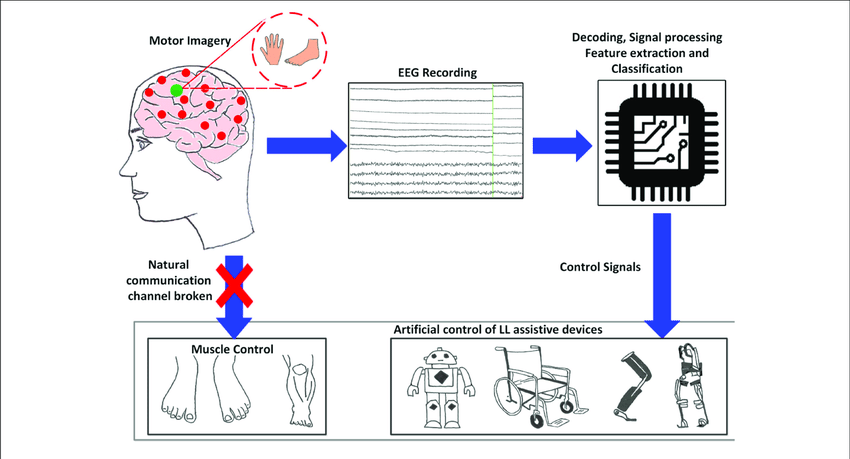The brain, like a computer uses electricity to function. This makes it possible to connect the brain with the outside world, just like it is connected with the physical body. Brain computer interfaces (BCIs) use electrical signals generated by the brain to control and interact with external devices so that users are less dependent on muscles to act upon the world (Lara n.d.). BCIs are mostly used in the medical industry to help people with disabilities function independently however, as the technology continues to develop so does its range of potential applications.
In recent years, increased investments from tech and medical corporations alike have broadened the focus of BCIs into the field of augmenting humans, viewing the technology as a way to improve our own natural abilities. Cyborgs, once merely science fiction, may now a step closer to reality with brain computer interfaces merging mind and machine.
How Does It Work?
The human brain behaves like a CPU, processing information with the help of 86 billion neurons that work whenever we move, feel, think or remember (BrainFacts 2018). These neurons communicate via electrical impulses that can be picked up using electrophysical methods like an electroencephalogram (EEG)(Alexandre 2018). An EEG conducts brain’s signals using electrodes and provides the data to the BCI program which then translates it into an external action using algorithms.
A subject fitted to a BCI with a mechanical arm would operate it by visualizing moving their own hand. If the person were to imagine him/herself wave, the machine learning algorithms would match the EEG recording to the specified action and send out commands for the arm to execute.
There are three types of BCI devices available; non-invasive, semi-invasive and invasive (Alexandre 2018). Non-invasive BCIs like the EEG are the preferred option, as it sits on the scalp and do not require surgery. (Frost & Sullivan 2017). The drawback of this method however, is that the signal received is weak and contains a lot of static because of the skull. In order to get better readings, the electrodes have to be placed much closer to the brain which is where semi-evasive and evasive BCIs come into play. These BCIs require minimal to critical surgery and are placed beneath the skull, on or inside the brain itself. A more-direct communication to the brain allows for less noise and provides a two-way communication link (Emotiv 2020), meaning the brain can provide data to the computer and receive information as well. This is how a cochlear implant would pass sound waves as electrical signals to the brain in order to restore hearing to the deaf.
Brief History
Impact of BCIs
Brain-computer interfaces have the potential to drastically change how humans interact with the environment and each other. It’s best-known application is in healthcare, where the technology has proven the ability to restore mobility and senses to people with neuromuscular conditions (Patrick et al. 2020). With Elon’s Neuralink and Facebook’s own BCI program, the scope of BCIs has grown outside of medicine to include consumer-oriented applications such as personal entertainment, gaming (Minkyu et al. 2014 pp. 14601) and communication. To able to control a device simply by using your brain provides a lot opportunities across a lot of industries, especially when you implement it together with other emergent technologies like VR, IOT, and AI. The dream of waking up to a fresh cup of coffee could someday become a reality when you combine the power of BCI technology with the Internet of Things (IOT). There are many possibilities for how a BCI can be used, even malicious ones, which is why there are already organizations working on issues like neuroethics and neural security to protect future users’ privacy.
At current stages, BCI devices are still relatively basic but it is only a matter of time before the technology becomes truly capable. Once decoding brain signals into machine language is perfected, the potential of BCIs is limitless. Just as mobile phones have transformed our lives in the past, the development of BCI technology could fundamentally change the way we live and communicate.
References
Alexandre Gonfalonieri 2018, A Beginner’s Guide to Brain-Computer Interface and Convolutional Neural Networks, Towards Data Science, retrieved 3 May 2020, <https://towardsdatascience.com/a-beginners-guide-to-brain-computer-interface-and-convolutional-neural-networks-9f35bd4af948>.
Allison, B, Graimann, B & Graeser, A 2008, ‘Why use a BCI if you’re healthy?’, Intelligent Systems, IEEE, vol 23, pp.7-11, <http://citeseerx.ist.psu.edu/viewdoc/download;jsessionid=6E1F09A4538B93D503B58CCA37A8801B?doi=10.1.1.303.355&rep=rep1&type=pdf>.
Andrew 2016, Brain-Computer-Interface (1), photograph, retrieved 5 May 2020, <https://alsadotorg.wordpress.com/2016/06/02/bringing-brain-computer-interface-home/>.
BrainFacts 2018, How Many Neurons Are in the Brain?, BrainFacts, retrieved 3 May 2020, <https://www.brainfacts.org/in-the-lab/meet-the-researcher/2018/how-many-neurons-are-in-the-brain-120418>.
CreativeCommons 2018, Figure 1, photograph, retrieved 7 May 2020, <https://www.researchgate.net/figure/Generic-concept-function-diagram-of-BCI-controlled-assistive-LL-devices-based-on-motor_fig1_326853879>.
Emotiv 2020, The Introductory Guide to BCI(Brain-Computer Interface), Emotiv, retrieved 4 May 2020, <https://www.emotiv.com/bci-guide/>.
Frost & Sullivan 2017, Brain-Computer Interface Hold a Promising Future, Alliance of Advanced BioMedical Engineering, retrieved 3 May 2020, <https://aabme.asme.org/posts/brain-computer-interface-the-most-investigated-areas-in-health-care-hold-a-promising-future>.
Lara Fernandez, A n.d., How brain–computer interface is merging mind and machine, This.Deakin, retrieved 1 May 2020, <https://this.deakin.edu.au/innovation/how-brain-computer-interface-is-merging-mind-and-machine>.
Minkyu, M, J & Sung Chan Jun, E 2014 ‘A review of brain-computer interface games and an opinion survey from researchers, developers and users’, Sensors (Basel, Switzerland), vol. 14,8, pp.14601-33, doi:10.3390/s140814601
Patrick, S, Michael, D, Collin, C, Adam, D, Marcia & G 2020, ‘Restoring the Sense of Touch Using a Sensorimotor Demultiplexing Neural Interface’, ScienceDirect, doi:10.1016/j.cell.2020.03.054

